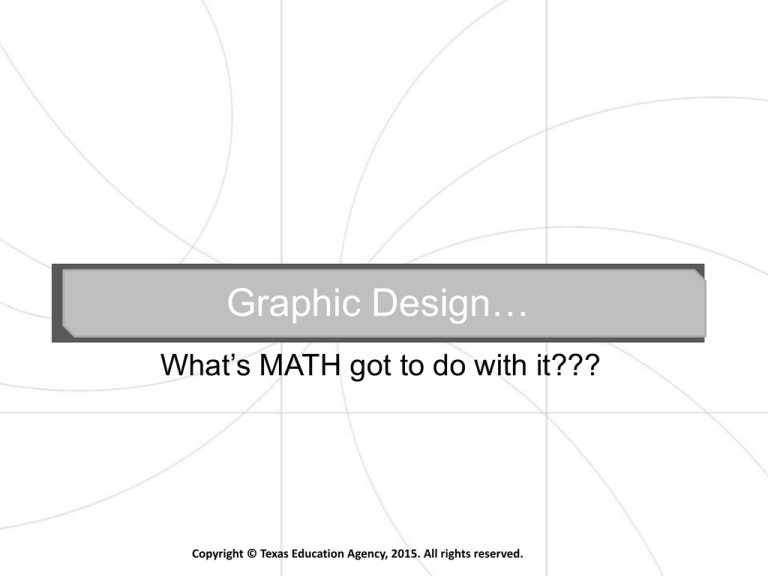
Graphic Design…
What’s MATH got to do with it???
Copyright © Texas Education Agency, 2015. All rights reserved.
Isn’t graphic design just art?
Graphic design is just used to create beautiful artwork,
logos, signs or posters, right?
It is concerned with things like:
• Creativity
• Artistic
• Colors
• Typography
• Special effects
Copyright © Texas Education Agency, 2015. All rights reserved.
Where does MATH come in?
The truth is that graphic design is saturated with MATH!
•Raster design is resolution dependent, which means on the
number of points of colors or pixels per square inch.
•Vectors, while independent of resolution or pixels, are based
solely on mathematical functions or formulas to define
shapes, curves, objects, etc.
•Both use math for placement, scalability, exact movement,
alignment and file size – just to name a few!
Copyright © Texas Education Agency, 2015. All rights reserved.
MATH used in Raster design
Pixels are constantly working behind the scenes to prevent
“jaggies”or poor picture quality in rasters.
A few examples of math in raster design are:
•Pixels per inch (PPI) Dots per inch (DPI)
•Resolution
•Page size inches or pixels
•Scaling up or reducing
•File size
Copyright © Texas Education Agency, 2015. All rights reserved.
MATH used in vector design.
Vector design is totally dependent on MATH. It does not
use pixels.
Examples in vector design are:
• Anchor points
• Bezier curves
• Area
• Gradient fades
• File size
Copyright © Texas Education Agency, 2015. All rights reserved.
Let’s look at some calculations
Web traditionally uses 72 dots/pixels per inch for best
results.
To find the needed pixel size for web banner 10 by 3 inches:
– 72dpi x the width (72 x 10= 720)
– 72dpi x height (72 x 3 = 216)
So the needed size would be width 720 and height 216 in pixels.
Print traditionally uses 300 dpi for best results.
To find the needed pixel size for header 10 by 3 inches:
– 300 dpi x the width (300 x 10= 3000)
– 300 dpi x height (300 x 3 = 900)
So the needed size would be width 3000 and height 900 in pixels.
Copyright © Texas Education Agency, 2015. All rights reserved.
Let’s look at some calculations
You found a picture you want to use for web and don’t want
to get the “jaggies.” How do you know what the numbers
mean?
Take the given measurements of the photo and divide by 72.
This photo is 216 x 180. So do the math!
•216 pixels width / 72dpi (216 / 72 = 3 in wide.)
•180 height 180/ 72 = 2.5 in high.)
•So, the best use of this photo would be at
3 x 2.5 inches or less like shown here.
Neuschwanstein, Germany. en.wikipedia. org
Copyright © Texas Education Agency, 2015. All rights reserved.
Calculating Pixels
Using this same photo for print makes a big difference due
to the preferred resolution. Now you would divide by 300!
So taking the same photo measurements – 216 x 180 and calculating for print
this is what we get:
•216 width (216 / 300 = .72 in wide.)
•180 height (180 / 300 = .6 in high.)
•That comes out to roughly ¾ “ x ½ “ like the picture here!
•Unless you want the picture to really be less
than an inch high and wide, find a higher
resolution picture! i.e. to have the picture at the 3 x 2.5 in size for print
you would need 900 x 750 (300 x 3 = 900 & 300 x 2.5 = 750)
Neuschwanstein, Germany. en.wikipedia. org
Copyright © Texas Education Agency, 2015. All rights reserved.
Calculating Resolution
The resolution for the web peaks at 72dpi.
•So if you want a banner that is 9” wide by 2” high then it would be as
follows:
•9 x 72 = 648
•2 x 72 = 144
So your resolution would be 720 x 216
Copyright © Texas Education Agency, 2015. All rights reserved.
Calculating Increased Size
If you have a picture and it is 2” x 2.5” and you want it to be increased
in size by ¼ you would take 100% (the original size) and add 25%
(1/4 increase),which yields 125% and multiply.
•2 x 1.25= 2.5
•2.5 x 1.25 = 3.125
•So your picture size would be 2.5” x 3.125” and look something like
this!
Copyright © Texas Education Agency, 2015. All rights reserved.
Calculations to Reduce Size
• If you have a 3” square and you want to reduce it by
25% then you subtract that percentage from 100% and
multiply. It looks like this: 100%-25%= 75%
• 3 x .75= 2.25
• So your reduced square would be 2.25”
Copyright © Texas Education Agency, 2015. All rights reserved.
Math in Good Principles of Design
Also, saturated with MATH are the very principles of design
we use to make our projects and artwork beautiful!
Some examples that use math are:
• Rule of Thirds
• Symmetry/Asymmetry
• Fibonacci
• Golden Ratio
• Proximity/Hierarchy
• Rhythm
Copyright © Texas Education Agency, 2015. All rights reserved.
Check out the Math!
• Look up some of the mathematical formulas
associated with the Principles of Design. They
are fascinating and make a great research
project!
HAVE FUN WITH MATH IN ART!
Copyright © Texas Education Agency, 2015. All rights reserved.






